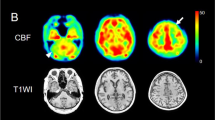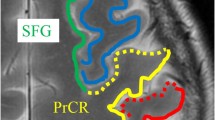Abstract
Introduction
Diagnosing corticobasal degeneration is often difficult on the basis of clinical symptoms and radiological images. We aimed to clarify the imaging findings of corticobasal degeneration syndrome (CBDS).
Methods
Included in the study were 16 patients (8 men, 8 women, 46–75 years old) with clinically diagnosed CBDS. We evaluated the patients’ symptoms and signs, and MR and single-photon emission CT (SPECT) imaging findings.
Results
All the patients had cerebral atrophy. Asymmetric cerebral atrophy was observed in 13 patients (81%) predominantly contralateral to the side clinically more affected. Atrophy in the cerebral peduncle was observed in seven patients. FLAIR images showed hyperintensity in the subcortical white matter in the frontoparietal lobes in the clinically more affected side in 14 patients, and in the rolandic region in 13 patients. Asymmetric hypoperfusion in the frontoparietal lobes on SPECT images was observed in all of the patients, and in the basal ganglia in 11 patients.
Conclusion
CBDS might be unique in showing hyperintensity in the subcortical white matter in the rolandic region on FLAIR images with asymmetric atrophy predominantly contralateral to the side clinically more severely affected. Asymmetric atrophy in the cerebral peduncle without signal abnormalities was also characteristic of CBDS. Atrophy in the midbrain tegmentum was also seen in patients with CBDS.



Similar content being viewed by others
References
Boeve BF, Lang AE, Litvan I (2003) Corticobasal degeneration and its relationship to progressive supranuclear palsy and frontotemporal dementia. Ann Neurol 54(Suppl 5):S15–S19
Lowe JS, Leigh N (2002) Corticobasal degeneration. In: Graham DI, Lantos PL (eds) Greenfield’s neuropathology, 7th edn, vol. 2. Arnold, London, pp 346–350
Shannon KM (2004) Corticobasal degeneration. In: Bradley WG, Daroff RB, Fenichel GM, Jankovic J (eds) Neurology in clinical practice, 4th edn, vol. 2. Butterworth Heinemann, Philadelphia, p 2142
Doran M, du Plessis DG, Enevoldson TP, Fletcher NA, Ghadiali E, Larner AJ (2003) Pathological heterogeneity of clinically diagnosed corticobasal degeneration. J Neurol Sci 216:127–134
Matsuda H, Yagishita A, Tsuji S, Hisada K (1995) A quantitative approach to technetium-99m ethyl cysteinate dimer; a comparison with technetium-99m hexamethylpropylene amine oxime. Eur J Nucl Med 22:633–637
Galton CJ, Patterson K, Xuereb JH, Hodges JR (2000) Atypical and typical presentations of Alzheimer’s disease: a clinical, neuropsychological, neuroimaging and pathological study of 13 cases. Brain 123:484–498
Kaida K, Takeda K, Nagata N, Kamakura K (1998) Alzheimer’s disease with asymmetric parietal lobe atrophy: a case report. J Neurol Sci 160:96–99
Giannakopoulos P, Hof PR, Bouras C (1994) Alzheimer’s disease with asymmetric atrophy of the cerebral hemispheres: morphometric analysis of four cases. Acta Neuropathol (Berl) 88:440–447
Grossman RI, Yousem DM (2003) Neuroradiology: the requisites, 2nd edn. Mosby, Philadelphia, p 387
Parent A (1996) Carpenter’s human neuroanatomy, 9th edn. Williams & Wilkins, Baltimore, pp 452–456
Tsuchiya K, Murayama S, Mitani K, Oda T, Arima K, Mimura M, Nagura H, Haga C, Akiyama H, Yamanouchi H, Mizusawa H (2005) Constant and severe involvement of Betz cells in corticobasal degeneration is not consistent with pyramidal signs: a clinicopathological study of ten autopsy cases. Acta Neuropathol 109:353–366
Boelmans K, Kaufmann J, Bodammer N, Heinze HJ, Niehaus L (2006) Corticospinal tract atrophy in corticobasal degeneration. Arch Neurol 63:462–463
Yagishita A, Oda M (1996) Progressive supranuclear palsy: MRI and pathological findings. Neuroradiology 38(Suppl 1):S60–S66
Oba H, Yagishita A, Terada H, Barkovich AJ, Kutomi K, Yamauchi T, Furui T, Shimizu T, Uchigata M, Matsumura K, Sonoo M, Sakai M, Takada K, Harasawa A, Takeshita K, Kohtake H, Tanaka H, Suzuki S (2005) New and reliable MRI diagnosis for progressive supranuclear palsy. Neurology 64:2050–2055
Doi T, Iwasa K, Makifuchi T, Takamiri M (1999) White matter hyperintensities on MRI in a patient with corticobasal degeneration. Acta Neurol Scand 99:199–201
Winkelmann J, Auer DP, Lechner C, Elbel G, Trenkwalder C (1999) Magnetic resonance imaging findings in corticobasal degeneration. Mov Disord 14:669–673
Mirra SS, Hyman BT (2002) Corticobasal degeneration. In: Graham DI, Lantos PL (eds) Greenfield’s neuropathology, 7th edn, vol. 2. Arnold, London, pp 231–232
Hecht MJ, Fellner F, Fellner C, Hilz MN, Heuss D, Neundorfer B (2001) MRI-FLAIR images of the head show corticospinal tract alterations in ALS patients more frequently than T2-, T1- and proton-density-weighted images. J Neurol Sci 186:37–44
Oba H, Araki T, Ohtomo K, Monzawa S, Uchiyama G, Koizumi K, Nogata Y, Kachi K, Shiozawa Z, Kobayashi M (1993) Amyotrophic lateral sclerosis: T2 shortening in motor cortex at MR imaging. Radiology 189:843–846
Matsusue E, Kinoshita T, Ohama E, Ogawa T (2005) Cerebral cortical and white matter lesions in chronic hepatic encephalopathy: MR-pathologic correlations. AJNR Am J Neuroradiol 26:347–351
Kitagaki H, Mori E, Hirono N, Hirono N, Ikejiri Y, Ishii K, lmamura T, Ikeda M, Yamaji S, Yamashita H, Shimomura T, Nakagawa Y (1997) Alteration of white matter MR signal intensity in frontotemporal dementia. AJNR Am J Neuroradiol 18:367–378
Acknowledgement
We thank Shouki Takahashi, MD, for his advice.
Conflict of interest statement
We declare that we have no conflict of interest.
Author information
Authors and Affiliations
Corresponding author
Additional information
Conflict of interest statement
We declare that we have no conflict of interest.
Rights and permissions
About this article
Cite this article
Koyama, M., Yagishita, A., Nakata, Y. et al. Imaging of corticobasal degeneration syndrome. Neuroradiology 49, 905–912 (2007). https://doi.org/10.1007/s00234-007-0265-6
Received:
Accepted:
Published:
Issue Date:
DOI: https://doi.org/10.1007/s00234-007-0265-6




